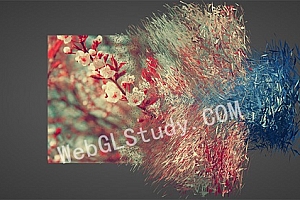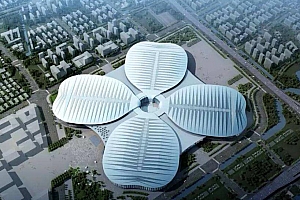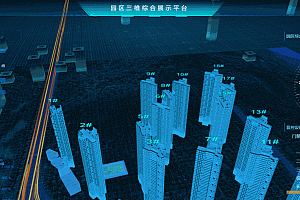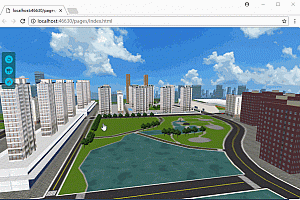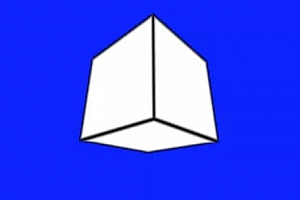C++编程实现DEM转换为gltf模型
1. 概述
DEM(地形文件)天然自带三维信息,可以将其转换成gltf模型文件。DEM是栅格数据,可以通过GDAL进行读取;gltf是一种JSON格式,可以采用nlohmann/json进行读写。
2. 详细
直接把代码贴出来(C++版本 OpenGL):
#include <iostream>
#include <fstream>
#include <iomanip>
#include <nlohmann/json.hpp>
#include "fifo_map.hpp"
#include <gdal/gdal_priv.h>
using namespace std;
using namespace nlohmann;
// A workaround to give to use fifo_map as map, we are just ignoring the 'less' compare
template<class K, class V, class dummy_compare, class A>
using my_workaround_fifo_map = fifo_map<K, V, fifo_map_compare<K>, A>;
using my_json = basic_json<my_workaround_fifo_map>;
int main()
{
GDALAllRegister();
CPLSetConfigOption("GDAL_FILENAME_IS_UTF8", "NO"); //支持中文路径
my_json gltf;
gltf["asset"] = {
{"generator", "CL"},
{"version", "2.0"}
};
gltf["scene"] = 0;
gltf["scenes"] = {
{{"nodes", {0} }}
};
gltf["nodes"] = {
{{"mesh", 0}}
};
my_json positionJson;
positionJson["POSITION"] = 1;
positionJson["TEXCOORD_0"] = 2;
my_json primitivesJson;
primitivesJson = {
{{"attributes", positionJson}, {"indices", 0}, {"material", 0} }
};
gltf["meshes"] = {
{{"primitives", primitivesJson}}
};
my_json pbrJson;
pbrJson["baseColorTexture"]["index"] = 0;
gltf["materials"] = {
{{"pbrMetallicRoughness", pbrJson}}
};
size_t pointNum = 0;
size_t binBufNum = 0;
size_t indicesNum = 0;
{
string binPath = "D:/Work/WebGLTutorial/Data/new.bin";
ofstream binFile(binPath, std::ios::binary);
const char *filePath = "D:/Work/WebGLTutorial/Data/DEM.tif";
GDALDataset* img = (GDALDataset *)GDALOpen(filePath, GA_ReadOnly);
if (!img)
{
printf("Can't Open Image!");
return 0;
}
int bufWidth = img->GetRasterXSize(); //图像宽度
int bufHeight = img->GetRasterYSize(); //图像高度
int bandNum = img->GetRasterCount(); //波段数
if (bandNum != 1)
{
printf("DEM波段数不为1");
return 0;
}
int depth = GDALGetDataTypeSize(img->GetRasterBand(1)->GetRasterDataType()) / 8; //图像深度
//获取地理坐标信息
double padfTransform[6];
if (img->GetGeoTransform(padfTransform) == CE_Failure)
{
printf("获取仿射变换参数失败");
return 0;
}
double startX = padfTransform[0];
double dX = padfTransform[1];
double startY = padfTransform[3];
double dY = padfTransform[5];
//申请buf
size_t imgBufNum = (size_t)bufWidth * bufHeight * bandNum;
float *imgBuf = new float[imgBufNum];
//读取
img->RasterIO(GF_Read, 0, 0, bufWidth, bufHeight, imgBuf, bufWidth, bufHeight,
GDT_Float32, bandNum, nullptr, bandNum*depth, bufWidth*bandNum*depth, depth);
pointNum = (size_t)bufWidth * bufHeight;
size_t position_texture_num = pointNum * 5;
float *position_texture = new float[position_texture_num];
for (int yi = 0; yi < bufHeight; yi++)
{
for (int xi = 0; xi < bufWidth; xi++)
{
size_t n = (size_t)(bufWidth * 5) * yi + 5 * xi;
position_texture[n] = dX * xi;
position_texture[n+1] = dY * yi;
size_t m = (size_t)(bufWidth * bandNum) * yi + bandNu
m * xi;
position_texture[n + 2] = imgBuf[m];
position_texture[n + 3] = float(xi) / (bufWidth-1);
position_texture[n + 4] = float(yi) / (bufHeight-1);
}
}
//释放
delete[] imgBuf;
imgBuf = nullptr;
binFile.write((char*)position_texture, position_texture_num * sizeof(float));
size_t vertexBufNum = position_texture_num * sizeof(float);
binBufNum = binBufNum + vertexBufNum;
int mod = vertexBufNum % sizeof(uint16_t);
if (mod != 0)
{
int spaceNum = sizeof(float) - mod;
char *space = new char[spaceNum];
binBufNum = binBufNum + sizeof(char) * spaceNum;
memset(space, 0, sizeof(char) * spaceNum);
binFile.write(space, sizeof(char) * spaceNum);
delete[] space;
space = nullptr;
}
indicesNum = (size_t)(bufWidth - 1) * (bufHeight - 1) * 2 * 3;
uint16_t *indices = new uint16_t[indicesNum];
for (int yi = 0; yi < bufHeight-1; yi++)
{
for (int xi = 0; xi < bufWidth-1; xi++)
{
uint16_t m00 = (uint16_t)(bufWidth * yi + xi) ;
uint16_t m01 = (uint16_t)(bufWidth * (yi+1) + xi);
uint16_t m11 = (uint16_t)(bufWidth * (yi + 1) + xi + 1);
uint16_t m10 = (uint16_t)(bufWidth * yi + xi + 1);
size_t n = (size_t)(bufWidth - 1) * yi + xi;
indices[n * 6] = m00;
indices[n * 6 + 1] = m01;
indices[n * 6 + 2] = m11;
indices[n * 6 + 3] = m11;
indices[n * 6 + 4] = m10;
indices[n * 6 + 5] = m00;
}
}
binFile.write((char*)indices, sizeof(uint16_t) * indicesNum);
binBufNum = binBufNum + sizeof(uint16_t) * indicesNum;
delete[] position_texture;
position_texture = nullptr;
delete[] indices;
indices = nullptr;
}
gltf["textures"] = {
{{"sampler", 0}, {"source", 0}}
};
gltf["images"] = {
{{"uri", "tex.jpg"}}
};
gltf["samplers"] = {
{{"magFilter", 9729}, {"minFilter", 9987}, {"wrapS", 33648}, {"wrapT", 33648}}
};
gltf["buffers"] = {
{{"uri", "new.bin"}, {"byteLength", binBufNum}}
};
my_json indicesBufferJson;
indicesBufferJson["buffer"] = 0;
indicesBufferJson["byteOffset"] = pointNum * 5 * 4;
indicesBufferJson["byteLength"] = indicesNum * 2;
indicesBufferJson["target"] = 34963;
my_json positionBufferJson;
positionBufferJson["buffer"] = 0;
positionBufferJson["byteStride"] = sizeof(float) * 5;
positionBufferJson["byteOffset"] = 0;
positionBufferJson["byteLength"] = pointNum * 5 * 4;
positionBufferJson["target"] = 34962;
gltf["bufferViews"] = {
indicesBufferJson, positionBufferJson
};
my_json indicesAccessors;
indicesAccessors["bufferView"] = 0;
indicesAccessors["byteOffset"] = 0;
indicesAccessors["componentType"] = 5123;
indicesAccessors["count"] = indicesNum;
indicesAccessors["type"] = "SCALAR";
indicesAccessors["max"] = { 18719 };
indicesAccessors["min"] = { 0 };
my_json positionAccessors;
positionAccessors["bufferView"] = 1;
positionAccessors["byteOffset"] = 0;
positionAccessors["componentType"] = 5126;
positionAccessors["count"] = pointNum;
positionAccessors["type"] = "VEC3";
positionAccessors["max"] = { 770, 0.0, 1261.151611328125 };
positionAccessors["min"] = { 0.0, -2390, 733.5555419921875 };
my_json textureAccessors;
textureAccessors["bufferView"] = 1;
textureAccessors["byteOffset"] = sizeof(float) * 3;
textureAccessors["componentType"] = 5126;
textureAccessors["count"] = pointNum;
textureAccessors["type"] = "VEC2";
textureAccessors["max"] = { 1, 1 };
textureAccessors["min"] = { 0, 0 };
gltf["accessors"] = {
indicesAccessors, positionAccessors, textureAccessors
};
string jsonFile = "D:/Work/WebGLTutorial/Data/new.gltf";
std::ofstrea
m outFile(jsonFile);
outFile << std::setw(4) << gltf << std::endl;
}
1.这里使用的DEM是tif格式的图像,使用GDAL读取。由于显示模型文件不需要大坐标,所以没有把DEM的起始XY坐标值算进去。同时附带了一张纹理贴图,正好覆盖整个DEM的范围。
2.转换的的原理非常简单,就是将DEM的每个网格绘制成两个三角形,通过顶点索引进行绘制。gltf具体的规范可以参看github上的教程,网上还有相关的中文翻译。
3.原生的nlohmann/json组件写出来的JSON格式是根据字符串顺序排序不是根据插入顺序排序的,查阅的时候不方便。所以这里使用了nlohmann::fifo_map容器专门化对象类型。
3. 结果
转换出来的结果用OSG显示如下:

4. 参考
[1] github上的gltf教程
[2] gltf教程中文翻译
[3] nlohmann/json关于保留插入顺序的讨论
WEBGL学习网(WebGLStudy.COM)专注提供WebGL 、ThreeJS、BabylonJS等WEB3D开发案例源码下载。
声明信息:
1. 本站部分资源来源于用户上传和网络,如有侵权请邮件联系站长:1218436398@qq.com!我们将尽快处理。
2. 分享目的仅供大家学习和交流,您必须在下载后24小时内删除!
3. 不得使用于非法商业用途,不得违反国家法律。否则后果自负!
4. 本站提供的源码、模板、插件等等其他资源,都不包含技术服务请大家谅解!
5. 如有链接无法下载、失效或广告,请联系管理员处理!
6. 本站资源打赏售价用于赞助本站提供的服务支出(包括不限服务器、网络带宽等费用支出)!
7.欢迎加QQ群学习交流:549297468 ,或者搜索微信公众号:WebGL学习网
WEBGL学习网 » C++编程实现DEM转换为gltf模型
WEBGL学习网 » C++编程实现DEM转换为gltf模型

